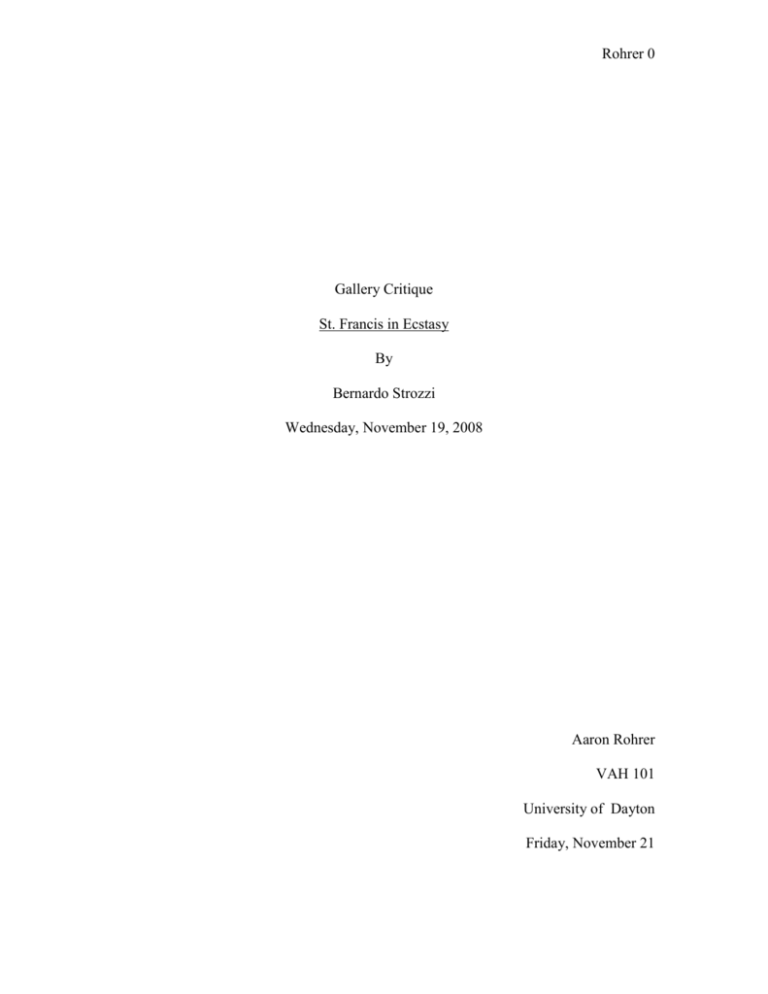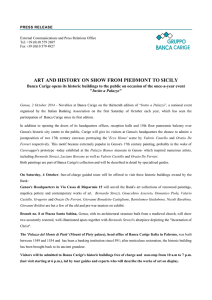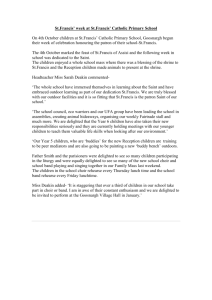Gallery Critique
advertisement

Rohrer 0 Gallery Critique St. Francis in Ecstasy By Bernardo Strozzi Wednesday, November 19, 2008 Aaron Rohrer VAH 101 University of Dayton Friday, November 21 Rohrer 1 Bernado Strozzi’s oil on canvas work, St. Francis in Ecstasy, is very magical. There are several different elements of art that the print possesses. This religious piece was created around 1615 to 1618, a period in time where religious art was very prevalent. The gallery in the Dayton Art Institute in which this piece was analyzed is entitled, “Century Italian Baroque Art.”, which was obviously the theme of it. Mr. and Mrs. Harry S. Price Jr patronized St. Francis in Ecstasy to the Dayton Art Institute in 1966. Along with the paintings very unique story, Bernardo Strozzi’s biographical history is very compelling as well. Bernardo Strozzi was a very prominent artist born in 1581 in Italy. Most of his Italian Baroque work was done in Genoa but Strozzi also did some work later in his life in Venice. Strozzi was a very religious man; he was a member of a Capuchin monastery (a branch of the Franciscan Order) for 10 years (Dayton Art Institute). When Strozzi’s father died he left the monastery in order to take care of his mother. In 1625, Strozzi was accused of practicing art without a license. This accusation against Strozzi led to a brief imprisonment in Genoa (Loire 477-479). When his mother died in 1630, Strozzi was urged to return to Genoese monastery (Dayton Art Institute). Much to the demise of the monastery, Strozzi refused to go back to Genoa. Fearing punishments of the court, Strozzi fled to Venice where he continued his prominent career as a painter (Dayton Art Institute). It is said that Strozzi’s work was influenced by Rubens, who was in Genoa the same time that Strozzi was (Loire 477-479). Bernardo Strozzi created St. Francis in Ecstasy somewhere in-between 1615 and 1618. St. Francis is said to be one of “the most revered and frequently depicted of all Christendom (Dayton Art Institute).” Strozzi is known to have painted St. Francis nearly Rohrer 2 40 times (Dayton Art Institute). Despite being born a son of a very wealthy merchant, St. Francis refused his families riches and chose to live a life devoted to Christ. St. Francis started a holy order by the name of the Franciscans. Strozzi was also a Franciscan, perhaps that it why Strozzi painted him so many times. After leading a life of giving St. Francis decided to journey to the mountains and meditate, in hopes of becoming closer to God. Following many years of reflection, self-denial, and prayer, St. Francis experienced an extraordinary vision. This vision left his body with Christ’s five sacred wounds, also known as the stigmata. Iconography is very present throughout this painting. While looking at St. Francis’s hands one can very obviously tell this is part of the stigmata. The skull and crucifix in the painting are very vanitas. This suggests some form of death. The form of death that this painting is referring to is death by crucifixion. The small cross of Jesus being crucified suggests this form of death. The darkness of the picture in general is also very iconographic. These dark colors suggest some form of struggle or gloom. The look on St. Francis’s face also suggests that he is experiencing a very passionate pain in which he is accepting by simply crossing his arms. Strozzi strategically used line, shape, texture, value, space, and color to create a very moving piece of art. Although there are no noticeable uses of lines one’s eyes move in a diagonal direction across the painting. This diagonal direction starts at the head of St. Francis then moves to the skull in front of him and lastly ends up on St. Francis’s hands. There is also no formal use of line to create a drastic outline. The pattern or texture created by lines is also very minimal. This texture is clearly an impasto style. Strozzi used this impasto style to create very organic shapes. These organic shapes are Rohrer 3 very natural and earthy. However, Strozzi included one geometric shape in the painting, the crucifix. The crucifix of Jesus is located directly in front of St. Francis resting on the skull. This crucifix was painted by using very straight vertical and horizontal lines. The crucifix along with most of the painting is very high-key. However, there is, without question, areas in which strong contrast exist. The most noticeable point of contrast is St. Francis’s head and the halo that surrounds it. Strozzi made sure that the halo was the brightest color on the painting, and that behind the halo was the darkest color on the painting, which thus creates visible contrast. Other areas in which high contrast exist also. The skull in front of St. Francis along with his hands are very low-key colors with a high-key background. Although both of his hands are high in contrast Strozzi made his right hand over his heart brighter as a result of the darker colors behind it. These high and low key values create great chiaroscuro. Chiaroscuro is most noticeable on the side of St. Francis’s face. Although the perspective is not very relevant in this painting, it is linear. Strozzi used overlapping most visibly in St. Francis’s arms. Clearly, the color scheme throughout this painting is warm neutral colors. The most noticeable object throughout St. Francis in Ecstasy is undoubtedly the head of St. Francis. Using a halo, which possessed great contrast and light, created this focal point. This strong value contrast is what gives the painting some form of unity. While the manmade element, the crucifix, gives the painting its variety. The halo is a rounded or circular object; this shape is what gives the painting its rhythm. The skull, rocks, and head each posses this roundedness. The scale of this painting is very normal. This helps the artist create a style of realism. Which results in informal asymmetrical balance. Rohrer 4 St. Francis in Ecstasy created by Bernardo Strozzi is a magnificent painting with a very compelling story attached to it. This virtuoso painting is very similar to those of Strozzi’s Italian Baroque era. The great use of chiaroscuro throughout this piece of art is very common throughout Italian Baroque Art. St. Francis in Ecstasy would have fit perfectly with the Counter-Reformation Church that deeply inspired artists to paint art that was meant to, “uplift the thought and actions of the faithful, while bringing them back to the Roman Catholic Church (Dayton Art Institute).” Rohrer 5 Bibliography "Bernardo Strozzi." The Columbia Electronic Encyclopedia. 6th ed. Columbia UP. Dayton Art Institute Hansen, M.S. and J.Spicer, eds. “Masterpieces of Italian Painting”. The Walters Art Museum. London 2005. No. 43. Loire, Stephane. “Bernardo Strozzi.” Burlington. 1995.





